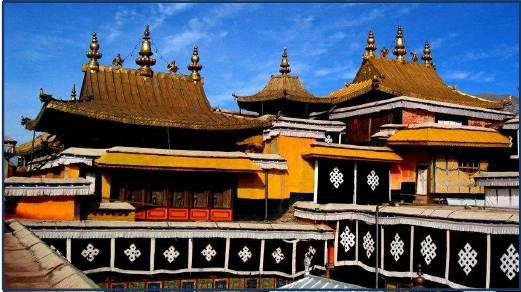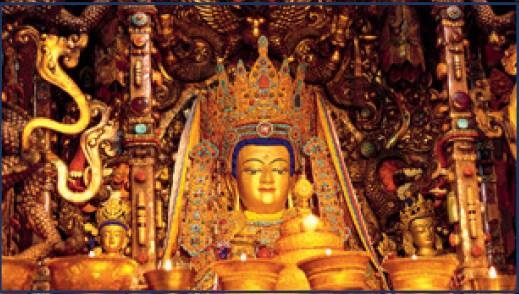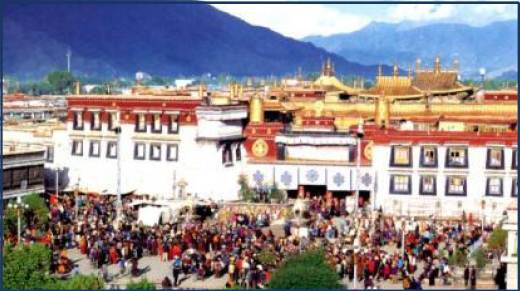| About Us | Site Map | Contact Us |
|
|
| Home | Schools & Teachings | Dharma Centers | Buddha & Bodhisattva Directory | Cosmos |
|
|
Buddhist Holy Sites in Tibet
|
The Jokhang, also called Zuglagkang is located on Barkhor Square in Lhasa. For most Tibetans it is the most sacred and important temple in Tibet. This Monastery was founded by king Songsten Gampo (649-676) for the two brides: Princess Wencheng of the Chinese Tang Dynasty and Princess Bhrikuti of Nepal. Both wives brought important Buddhist statues and images from China and Nepal to Tibet as part of their dowries. This included the Jowo Shakyamuni (or Jowo Rinpoche) from China which was said to have been personally blessed by the Buddha , is the most sacred statue in Tibet. 


Mount Kailash (a.k.a Mount Kailas) is considered a sacred place in four religions: Bön, Buddhism, Hinduism and Jainism.
It is known in the Tibetan language as Gang Ti-se and informally as Gang Rinpoche ("Precious Snow Mountain").
Tantric Buddhists believe that Mount Kailash is the home of the Buddha Demchok (a.k.a. Demchog or Chakrasamvara).
Traditionally a pilgrim undertakes the 52-km trek circumambulating around Mount Kailash commencing at Darchen (4575 m)
and crossing the Dolma La pass (5630 m) on the second day of the 3-day walk.
Lake Nam-tso (Heavenly Lake) is on the border between Damxung County of Lhasa Prefecture and Baingoin County of
Nagqu Prefecture in the Tibet Autonomous Region. Namtso means “Sky Lake” in Tibetan, and which is one of the three holy lakes.
Its cave hermitages have for centuries been the destination of Tibetan pilgrims.
The legend said this holy lake is the abode of Cakrasaṃvara Tantra.
Manasarovar Lake (Lake Manas; Mapam Yumco) is a freshwater lake in the Tibet Autonomous Region.
The legendary lake known as Anavatapta in Sanskrit and Anotatta in Pali, where Queen Maya is believed to have
conceived Buddha. The lake has a few monasteries on its shores, the most notable of which is the ancient
Chiu Gompa Monastery. According to Buddhist literature and teachings, the Buddha stayed and meditated near
this lake on several occasions.
The Samye Monastery or Samye Gompa is the first Buddhist monastery built in Tibet. First constructed between 775 and 779
by King Trisong Detsen and presided over by the Buddhist master Padmasambhava, it’s the first temple to be built in Tibet
with complete three Buddhist jewels of Buddha, Dharma and Sangha. The layout of the monastery resembles the mandala replicating
the universe described in the sutras, with the main temple representing the legendary Mount Meru in the center. Four larger halls and eight smaller halls are distributed around all sides of the central hall, symbolizing the four large continents and eight small ones.
Sakya Monastery also known as dPal Sa skya or Pel Sakya ("White Earth" or "Pale Earth") is a Buddhist monastery.
The seat of the Sakya or Sakyapa school of Tibetan Buddhism, it was founded in 1073, by Konchok Gyelpo (1034-1102),
originally a Nyingmapa monk of the powerful noble family of the Tsang and became the first Sakya Trizin.
Drepung Monastery (Rice Heap monastery) is one of the "great three" Gelukpa university monasteries of Tibet
(The other two are Ganden and Sera). It was founded in 1416 by Jamyang Choge Tashi Palden (1397–1449),
one of Tsongkhapa's main disciples. The monastery was named after the sacred abode in South India of Shridhanyakataka
and was the principal seat of the Gelugpa school before 1950. It used to house over 10,000 monks,
the monastery is now divided into what are known as the seven great colleges:
Gomang (sGo-mang), Loseling (Blo-gsal gling), Deyang (bDe-dbyangs), Shagkor (Shag-skor),
Gyelwa (rGyal-ba) or Tosamling (Thos-bsam gling), Dulwa (‘Dul-ba), and Ngagpa (sNgags-pa).
|
| About Us | Free Books | Site Map | Contact Us | ||
| Copyright © 1999-2020 Manjushri. All Rights Reserved. | ||
